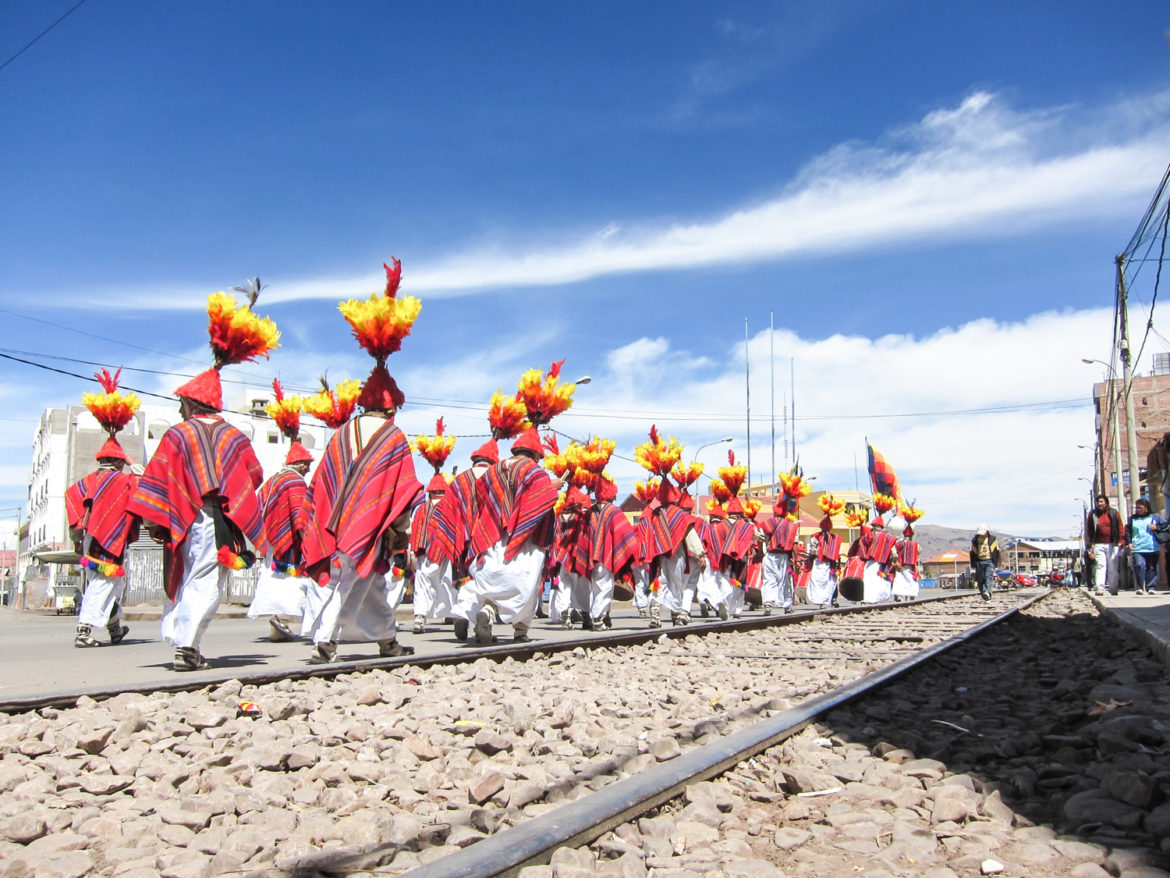Situated in the Altiplano, the high plateau of the Andes region, Puno is a picturesque lake town known as the Folkloric Capital of Peru.
From remote Cabanaconde, we took a local bus to the traditional market town of Chivay. From there, we transferred to a tourist bus headed directly to Puno. At $35pp, the tourist bus was a splurge for our meager budget, but cut our otherwise 12-hour journey in half. As an added bonus, we enjoyed super plush, comfortable seats (and no surprise llamas came on board like on our journey to Colca Canyon.)
Along the way, we stopped at Laguna Lagunillas. Nestled in a valley of the Sillapaka mountain range, this gorgeous blue lake is home to a variety of wildlife. After taking a few photos of the pink flamingo flocks, we continued east for two more hours.
From the start, Puno was a warm, welcoming city . As with the rest of Peru, we found it easy to fit in socially.
Taking a moto taxi from the bus station, we found a humble guesthouse to check into. Within an hour, we were out exploring the city. In Parque Pino, locals sat in the shade of umbrella-shaped trees to stay cool. Outside Puno Cathedral, a roving local photographer took photos of families dressed in their Sunday best. While in the Plaza de Armas, a large group of school boys in matching athletic gear swarmed past us, participating in a local 10k race.
After perusing the aisles of the farmer’s market, we wandered down various side streets, encountering different street vendors along the way. Our stomachs began to growl. Following the crowds, we ended up at an authentic polleria for a cheap and filling lunch. These Peru-specific restaurants serving fresh rotisserie chickens can be found everywhere throughout Peru.
Continuing our wanders, we climbed a bazillion steps to reach Condor Hill. From the Mirador de Kuntur Wasi, we took in the gorgeous, panoramic view of shimmering Lake Titicaca below. South America’s largest lake by volume, it’s also the world’s highest navigable body of water.
Unintentionally arriving in Puno on the anniversary of its founding, we got to witness firsthand a city that knows how to party.
Puno Day, as it was originally known, commemorates two historical events: the founding of Puno by the Spanish conquistadors and the establishment of the Inca Empire. Over the years, the festivities became drawn out and they now extend to a week. Peru holds about 3,000 festivals every year and by the standards of this one, the bar is set pretty high.
On the first day of the celebration, vendors began setting up food and beer stands early in the morning. As the number of people arriving grew, so did the electricity in the air. Groups of performers, dressed in spectacular traditional costumes, began practicing their music and dance routines. A sweet ten-year old girl manned her parents’ beer stand. She gave us a curious look as we approached to buy a couple of Cristals from her. We offered her a big smile. Immediately, her eyes lit up – she smiled back, then quickly took our money and put in her register.
Looking around, we noticed we appeared to be the only outsiders. We found a park bench to sit and enjoy our beers while taking in the activity.
Eventually, the performers lined up and took their instruments and dancing to the streets for an official performance. Women, adorned in bright red blouses with colorful pom-poms, gracefully twirled around in impossibly full skirts. Men in classic Peruvian hats and rainbow ponchos beat their drums in unison. A man adorned with an oversized headpiece of massive feathers, danced a quirky little jig. Despite all his hopping, he somehow managed to keep the hat on top of his head.
The camaraderie among everyone was infectious – from vendors to performers, men to women, adults to children. Each and every person had a role to play and seemed to take genuine pride in it. It was easy to understand why. These intricate costumes and incredible dances had been going on for centuries. A special tradition passed down from generation to generation.
As the sun went down, the festivities continued well into the wee hours of the evening. Hard working. Hard partying. This is how we remember the people of Puno, Peru.

